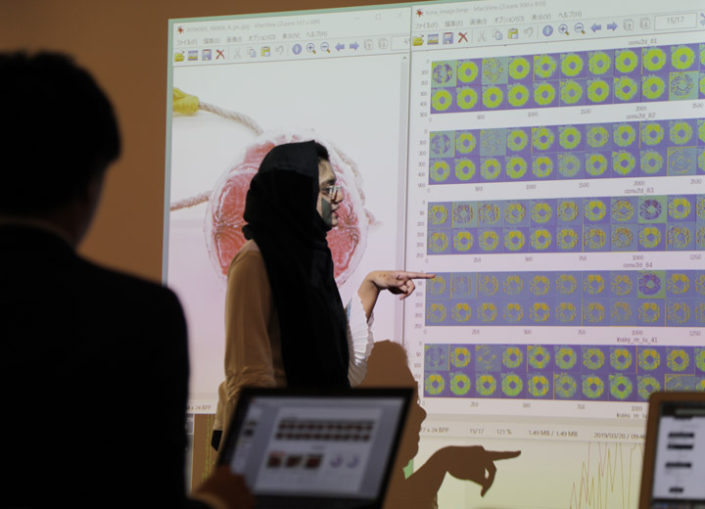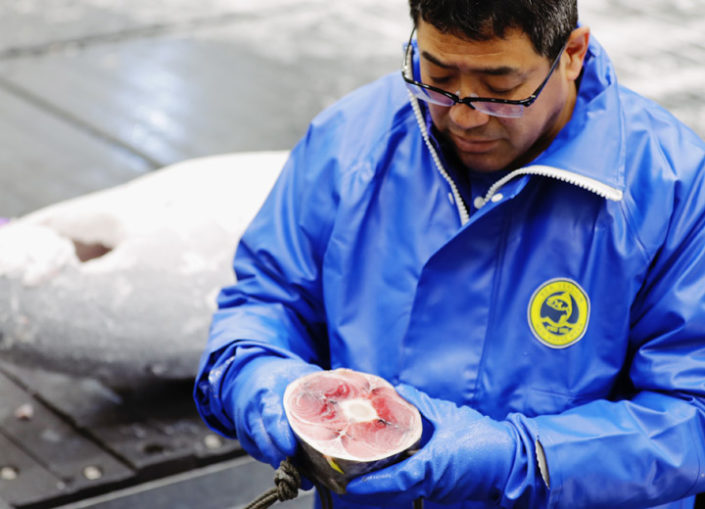Tuna examination is one of the many vital artisanal skills that supports the culinary culture revolving around this fish. It is a skill that allows master tuna merchants to determine properties such as the flavor and texture of a tuna just by eye without ever tasting it themselves. As the number of practitioners of this craft dwindle, these trade secrets are in danger of disappearing, so we decided to pass the torch to AI. When want to ensure that people around the world could enjoy the same standard of delicious tuna, even into the far future.
Tuna is one of the ocean’s greatest treasures.
Entrusting the Future of Tuna Examination to AI.
High-quality Tuna for All, Sustainably.
The Secrets to a Tuna’s Flavor are Hidden in the Tail.
The cross section of a tuna’s tail is a road map detailing an intricate story about it’s flavor, texture, freshness and overall quality. Master tuna merchants will examine things like the color and sheen, firmness, and the layering of fat, and through a process forged by experience and intuition, instantly determine the quality of a given fish. This examination has been the primary determiner of prices at fish markets for ages.

Inheriting the Disappearing Legacy of Tuna Examiners.
“No matter how talented someone may be, it takes at least ten years to be able to do this by yourself.” Quality examination is a skill that is cultivated from a combination of years of training, experience and individual intuition, and each practitioner has their own unique tried and true methods. The number of craftsmen, who judges the quality of fish with their highly trained eyes, has fallen to less than half of the industry’s golden age. In the near future, it’s feared that there will be no successors to carry on the occupation.
STORY
We created an AI model that instantaneously determines the quality of a given tuna based on a cross sectional tail scan. We took roughly 4,000 tail images, a number equivalent to that an examiner might see on their ten year path to proficiency, and input the data into the AI program, which succeeded in mastering the skill in a mere month through machine learning. This was the birth of a new successor to the tuna examination tradition that could be utilized around-the-clock anywhere in the world.
The Development of TUNA SCOPE
At a fish processing facility in Yaizu, yellowfin tuna data was recorded along with grades given by real examiners on a four-level scale. on a four to five level scale. Using machine learning, we took the data for roughly 4,000 fish and used it to teach AI the unexplainable nuances of the tuna examination craft.
Testing at the Yaizu Fish Processing Facility


The AI quality examination app was introduced to the yellowfin tuna inspection process at the Yaizu fish processing facility. We tested the app’s accuracy by comparing it to the results of real examiners, revealing that the app was already achieving accuracy level 78%85% as high as its human counterparts with 35 years of experience.
The Creation of “AI Tuna”


Promoting it in sushi restaurants. The tuna that was ranked highest by the AI went on to become its own brand, which was labeled “AI Tuna”. This high quality AI-examined tuna was brought to a sushi restaurant in Tokyo where roughly 1,000 plates were served to customers over five days. According to a survey executed at the restaurant, the brand achieved a 90% customer satisfaction rate.
TUNA SCOPE Goes Global

TUNA SCOPE’s next step is to become a real part of the inspection process at factories, and utilize the data to become increasingly skilled. By expanding beyond Japan, and continuing to acquire data from fisheries around the world, TUNA SCOPE aims to create a world standard for tuna quality in the near future.
FUTURE
Artisan Skills in the Hands of AI
The technology developed for TUNA SCOPE has untapped potential for applications across a wide variety of industries. By teaching AI the secrets and nuances required to perform the tasks humans have perfected over the years with the naked eye, we may gain a new ally against a host of problems that humanity faces today. That future might be closer than we think.















